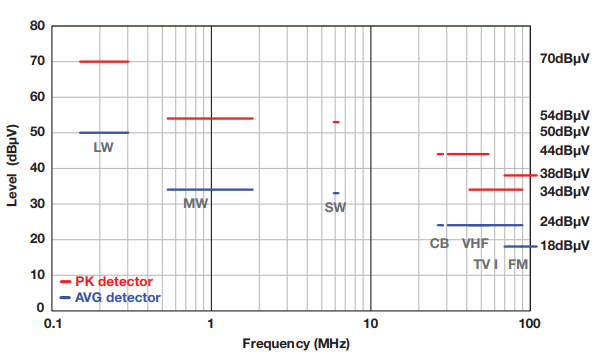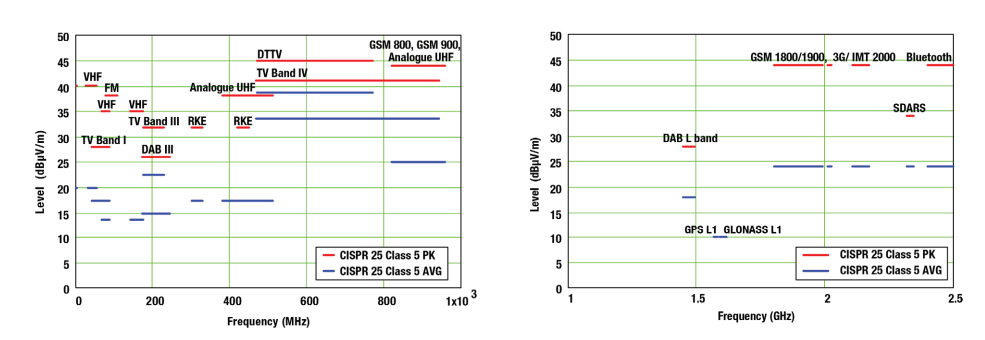Understanding EMI Allows Designers to Make an Informed Decision When Selecting a Switching Converter for Automotive Applications
By Tu Bui, Senior Marketing/Application Manager (DC-DC Business Unit)
Introduction
Electromagnetic interference (EMI) is a problematic feature of fast-switching power converters used in products across multiple markets. A converter that achieves regulatory compliance in one system may not automatically do so in another. In addition, EMI filtering may be required to achieve regulatory compliance, and this can be a significant portion of the overall system footprint, volume, and cost, so understanding the standards applicable to different applications is essential. This article reviews the source and types of EMI in switching converters before explaining the differences between the regulatory standards for products in the industrial and automotive markets. Finally, it shows the techniques used by Diodes Incorporated to enable one of its DC-DC switching converters to comply with stringent automotive standards.
Sources of EMI in Switching Converters
Switches in modern power supplies have very fast switching times, meaning faster rising and falling edges in voltage and current waveforms. These sharp edges produce significant energy at high frequencies and are the primary source of EMI in switched-mode power supplies. This high-frequency energy causes ringing in the resonant tanks within a power supply. There are two types of EMI emissions: conducted and radiated. Conducted emissions are carried on the wires and traces connected to a power converter. Since this noise is localized to a specific terminal or connector in a circuit, good board layout practice and filter design can ensure compliance with conducted emissions requirements relatively early in the design process. However, radiated emissions are more challenging. Everything on a PCB that carries current radiates an electromagnetic field. Every trace on the board is an antenna, and each copper plane is a resonator. Anything other than a pure sine wave or DC voltage generates noise across the entire signal spectrum. Even with careful design, a power supply designer can only understand how harmful the radiated emissions will be once the system is tested. Unfortunately, radiated emissions testing can only be performed once the design is complete. Filters can mitigate EMI by attenuating the strength of a signal at specific frequencies. Adding metallic and magnetic shields help to attenuate some of the radiated emissions, while ferrite beads and other filter types can help to reduce conducted emissions on PCB traces. EMI cannot be eliminated entirely but can be attenuated to a level that does not interfere with other communication or digital components.
EMI Standards for Conducted Emissions
Numerous governing bodies regulate the allowable levels of conducted and radiated emissions generated by equipment to maintain electromagnetic compatibility (EMC).
Consumer
For years, power supply products intended for use in communications and information technology (IT) end equipment within the EU have complied with the well-known European Standard EN 55022, derived mainly from the CISPR 22 product standard. However, CISPR 22/EN 55022 was recently incorporated into CISPR 32/EN 55032. This new emissions standard covers multimedia equipment and has become the effective harmonized EMC compliance standard. The EN 55022/32 Class A and Class B limits for conducted emissions cover quasi-peak and average signal detectors over the frequency range from 150kHz to 30MHz. Equipment intended for use in a residential environment must comply with Class B limits, with all other equipment complying with Class A.
Industrial
CISPR 11 is the international product standard for EMI for industrial, scientific, and medical (ISM) radio frequency (RF). It applies to various equipment, including wireless power transfer, charging equipment, Wi-Fi systems, induction cooking hobs, and arc welders. In addition, some industrial end equipment has dedicated system-level standards for EMC tests referenced in CISPR 11. For instance, IEC 61131-2 provides emission requirements for programmable logic controllers (PLC) widely used in factory automation and process control applications. Other system-level standards include IEC 61800-3, the EMC requirements for adjustable-speed motor drive systems, and IEC 61326-1 for laboratory equipment.
Automotive
For automotive electronic product designers, the relevant conducted emissions tests are those specified in CISPR 25. This international standard applies to automotive components and modules, with measurements performed using one or two 5µH/50Ω artificial networks (depending on the grounding configuration). This standard refers to the “protection of onboard receivers” from conducted noise measured over a frequency range from 150kHz to 108MHz in specific frequency bands. These frequency ranges are dispersed across the AM broadcast, FM broadcast, and mobile service bands, as shown in Figure 1. CISPR 25 specifics conducted emission limits for peak (PK), quasi-peak (QP), and average (AVG) signal detectors.

Figure 1. CISPR 25 Class 5 conducted emission limits
Table 1 shows the limits for Class 5, the most stringent requirement from CISPR 25. The limits are quite challenging, particularly the 18dBµV average (or 38dBµV peak) limit in the VHF and FM bands spanning 68MHz to 108MHz, as the parasitics in filter components degrade EMI filter attenuation at such frequencies.
Table 1. Conducted EMI limits
Table 2 shows a summary of the applicable standards for conducted emissions. CISPR standards apply to products in the EU, while FCC applies to the U.S.
Table 2. Summary of primary product standards for conducted emissions
EMI Standards for Radiated Emissions in Automotive
CISPR 25 covers radio reception in the vehicle and therefore has limits defined in bands for various radio services. The standard covers component or module emissions measurements and whole vehicle emissions tests using the antenna provided with the vehicle. Figure 2 shows the Class 5 radiated emission limits using peak (PK) and AVG detectors for components/modules for automotive applications. The lowest measurement frequency relates to the European longwave (LW) broadcast band of 150kHz to 300kHz, and the highest frequency is 2.5GHz (Bluetooth and Wi-Fi transmissions). Measurements are made using linearly polarized electric field antennas with nominal 50Ω output impedance. The CISPR 25 test standard for radiated emissions is more stringent than FCC or CISPR22, with the receiver being placed 1m away from a device under test (DUT) compared to 10m for CISPR 22.
Figure 2. CISPR 25 Class 5 radiated limits using the Absorber-Lined Shielded Enclosure (ALSE) test
Automotive Compliant DC-DC Buck Converter
The AP64350Q is an automotive-compliant, 3.5A, synchronous buck converter with a wide input voltage range of 3.8V to 40V. The device integrates a 75mΩ high-side power MOSFET and a 45mΩ low-side power MOSFET to provide high-efficiency step-down DC-DC conversion. In addition, it has been carefully designed to include features that reduce EMI. These include a proprietary gate driver scheme to resist switching node ringing without sacrificing MOSFET turn-on and turn-off times, which reduces high-frequency radiated EMI noise caused by MOSFET switching. The AP64350Q also features a Frequency Spread Spectrum (FSS) with a switching frequency jitter of ±6%, which reduces EMI by not allowing emitted energy to stay in any one frequency for a significant period.
EMI testing was performed on the AP64350Q to ensure compliance with CISPR 25 Class 5 limits for conducted and radiated emissions. Figure 3 shows the filtering stages for testing the AP64350Q while switching at 500kHz.
Figure 3. Schematic showing stages of EMI Filtering
Higher loads caused more EMI during testing, but this was expected. Even with these stage filters, a DUT may sometimes only meet EMI limits if it is shielded to contain all generated noise. The shield must be connected to 0V to provide optimum EMI performance. Using a grounded shield enabled the AP64350Q to comply with all CISPR 25 Class 5 limits, as shown in Table 3. While using a common mode inductor helped to improve EMI performance, this was marginal because most of the generated noise is differential.
Table 3. Results of conducted and radiated emissions testing on the AP64350Q buck DC-DC converter
Conclusion
Conducted and radiated EMI is associated with all electronic components, especially switching converters, so standards have been developed to regulate its impact in different markets and regions. CISPR 25 Class 5 specifies the criteria for products for automotive applications and is the most rigorous. Even well-designed switching converters can fail this standard unless multi-stage filtering and shielding techniques are used. The AP64350Q from Diodes Incorporated is a buck converter that complies with CISPR 25 Class 5 limits for automotive applications.
The Diodes logo is a registered trademark of Diodes Incorporated in the United States and other countries.
All other trademarks are the property of their respective owners.
© 2023 Diodes Incorporated. All Rights Reserved
This article originally appeared in Electronic Product Design & Test (UK) on August, 2023.
